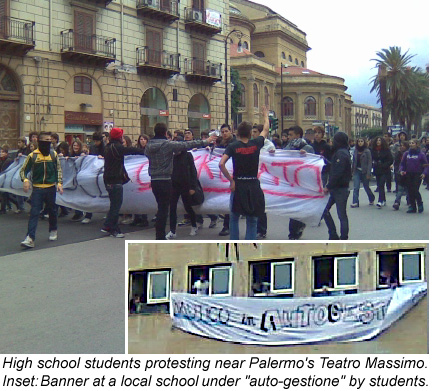...Best of Sicily presents... Best of Sicily Magazine. ... Dedicated to Sicilian art, culture, history, people, places and all things Sicilian. |
by Maria Luisa Romano | ||
Magazine Index Best of Sicily Arts & Culture Fashion Food & Wine History & Society About Us Travel Faqs Contact Map of Sicily |
The lax security implied by the senate break-in is bad enough, but where do high-school students get the right to take over schools, kicking the teachers out of classrooms for days or even weeks, while "camping out" in the buildings day and night? It's so incredible that anybody reading this will be forgiven if he or she simply does not believe it, but the phenomenon is easily confirmed (online) in the Italian press. We wrote about street protests some time ago; they're part of life in Italy. In some ways the sit-ins are more serious. They last longer, and they interfere with the important public service popularly known as "education." Student protests, in themselves, are hardly unique to Italy; British students violently protested substantial university fee increases weeks before the Italians, whose complaints about proposed "reforms" were so vague as to seem a mere pretext for avoiding lessons. In fact, among university students the Italians seemed to be manipulated by professors reluctant to see things like nepotism come to an end. Whatever university students get up to, at least they're adults. Most high school students are not, though Italy's normal graduation age is nineteen (high school in Italy lasts five long, restless years). The protests and sit-ins are part of the public (state) school environment. "Public" because, as you can imagine, they do not occur at private (Catholic or fee-paying) schools. Some years ago, a group of students of Palermo's Garibaldi classical-studies school made their way across the English Gardens to the Gonzaga Jesuit school, hoping to enlist its pupils in their "cause" of the moment. The guards at the gate simply refused to let them in. In the event of actual entry, had the police been called, the Garibaldi students would have been removed from Gonzaga's private campus. The incident, as it occurred, was comical. The main reason parents who can afford to send their children to Gonzaga, Don Bosco or other Catholic schools often do so is to avoid subjecting them to the nonsense of things like sit-ins and the extreme leftist political indoctrination foisted upon the pupils by some teachers in state schools. In reality, the teachers in state schools often manoeuvre students into staging the sit-ins, or tacitly condone the practice as an expression of "civil rights." What gives Italy's high-school students the right to stage sit-ins? Essentially, it is a poor reading of constitutional law and reluctance on the part of law enforcement to protect public order. Nothing more, nothing less. Where high-school students are concerned there are several important issues. The young students are protesting while they should be studying. They are acquiring an early cynicism and disdain for the social fabric of what is one of the world's major democracies. People nearing adulthood themselves are acquiring an early resentment of authority of any kind, while demonstrating a preference of extreme measures rather then diplomacy in resolving conflicts. Is it any wonder that Italian society is in chaos, and that there is very little nationalism or national pride among Italians? In practice, the secondary-school students engage in either "co-gestione" (joint administration) during which they permit teachers to teach, or "auto-gestione" (independent administration) during which teachers are called in to lessons only when needs be. Yes, the latter means that students "teach" themselves. Ridiculous, no? Discipline in Italian public schools is weak under the best of circumstances, and in fact little instruction of any kind takes place during sit-ins. If the situation deteriorates further to "occupazione" (simple occupation), then there are - officially and practically - no lessons at all and teachers go to school each day just to sign in. In other words, complete desuetude of state schools for days, weeks or even months. The young ringleaders of such sit-ins are almost unexceptionally aspiring "leftists" or pseudo-anarchists. (In Italy, protests and "anarchism" usually break for lunch and mamma's pasta.) The leaders, who might think twice before acting if real risk were involved, typically consider themselves "enlightened." In a reflection of Italian officialdom, they are usually male. Just a week before the current wave of sit-ins, the international edition of the American magazine Newsweek ran a cover story dedicated to the backward status - and media exploitation - of women in Italy (22 Nov, p 29-35). The boy "rebels," it seems, are not quite so revolutionary as they would have us believe. About the Author: Maria Luisa Romano has written about social topics for various Italian magazines, including this one. | |
Top of Page |
 Try
to imagine a bunch of students getting into Britain's House of Lords or
the United States Senate chamber and pelting a few of the members with eggs.
That's what happened to Italy's senators on November 25th (2010). Bizarre
as that may be, the same week saw a series of sit-ins as part of a typically
Italian phenomenon: occupation and control of schools by students as young
as fourteen.
Try
to imagine a bunch of students getting into Britain's House of Lords or
the United States Senate chamber and pelting a few of the members with eggs.
That's what happened to Italy's senators on November 25th (2010). Bizarre
as that may be, the same week saw a series of sit-ins as part of a typically
Italian phenomenon: occupation and control of schools by students as young
as fourteen.